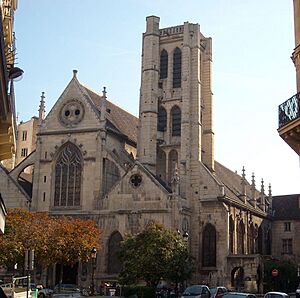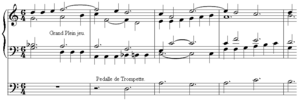Nicolas Gigault facts for kids
Nicolas Gigault (pronounced Nee-koh-LAH Gee-GOH) was a famous French Baroque organist and composer. He lived a long time ago, from about 1627 to 1707. Even though he started life with very little, he became well-known and respected by other musicians. Some of his music includes the very first examples of "noëls" (which are like variations on Christmas carols). He also wrote a lot of music that shows the style of French organ music from the mid-1600s.
The Life of Nicolas Gigault
We don't know much about Nicolas Gigault's early life. Some people thought he was born near Paris, but the exact place isn't clear. We also know he was born around 1627.
Nicolas's father, Estienne Gigault, worked at the law courts in Paris. Nicolas grew up in a poor family. His financial situation was difficult for a while. In 1648, he and his two younger brothers even gave up their right to inherit anything. This was to avoid taking on their father's debts. Nicolas's mother passed away when he was a child.
We don't know how Nicolas learned music or who his teachers were. Some historians have guessed, but there's no proof.
Nicolas Gigault's music career likely began in 1646. That's when he became the organist at a church called Saint-Honoré. In 1652, he moved to a similar job at Saint Nicolas-des-Champs. He worked there for the rest of his life. He also played the organ at Saint Martin-des-Champs starting in 1673. From 1685, he also worked at an orphanage called Hôpital du Saint Esprit.
Gigault got married twice. His first marriage was to Marie Aubert in 1662. They had five children together: two sons and three daughters. His sons, Anne-Joseph and Anne-Joachim, also became organists. One of his grandchildren, Augustin-Hypolite Ducastel, became a harpsichord-builder. Marie Aubert died in 1700. Gigault married again soon after, but he passed away a few years later in 1707.
Records of Gigault's belongings show that by 1662, he was no longer poor. He had a well-furnished home with paintings and sculptures. He also owned many musical instruments. These included a chamber organ, two harpsichords, three spinets, two clavichords, and several string instruments like a bass viol and a theorbo. Many of his paintings were religious. This, along with his music dedicated to the Blessed Virgin Mary, suggests that religion was very important to him. Besides being an organist, Gigault was also asked to give advice about organs. He was also a skilled musician who played other instruments.
Nicolas Gigault's Music
Nicolas Gigault published two collections of his organ music.
His first collection, called Livre de musique dédié а la Très Saincte Vierge, came out in 1682. This book has the earliest known examples of French "noëls." These are special pieces that are variations on Christmas carols or church hymns related to Christmas. The pieces usually start with two musical parts and then grow to four parts. The book also includes a dance piece called an "allemande." Gigault suggested that these pieces could be played on different instruments, not just the organ.
Gigault's second collection, Livre de musique pour l'orgue, was published in 1685. This book is much larger, with 184 pieces. It starts with three "organ masses." These masses use melodies from church chants. Gigault was special because he used these chant melodies in many different ways throughout his masses. The first and third masses are quite long, while the second one is very short.
The rest of this collection is organized by musical mode. It includes many "fugues" (a type of musical chase). It also has other common French musical forms like "dialogues" and "récits." The book also contains three hymns: Pange lingua, Veni Creator, and a full setting of the Te Deum.
Many experts believe that the music in Gigault's second book shows the style of French music from earlier in the 1600s, not just the very end. This suggests he might have put together older pieces he had written. Gigault had his own way of naming his musical forms. For example, he often used the word "fugue" more broadly than others. His music was written down very carefully, with lots of details about how it should be played.
Gigault's music has a serious and grand style. It was very suitable for church services. His "dialogues" (where different parts of the organ "talk" to each other) were more complex than those of other composers of his time. He also wrote pieces with five musical parts. His 1685 book was probably meant to show off his unique style. The music can be quite complex and requires a lot of skill to play.



